|
|
|
|
 |
|
MOROCCO, MARRAKESH |
|
MARRAKESH
On the Marrakesh Express
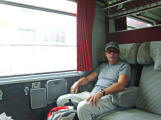 October 8, 2009 October 8, 2009
We boarded the train to Marrakesh,
somewhat enchanted to take a trip on the Marrakesh Express, made
famous by Cosby, Still Nash & Young. We paid a little extra for
"First Class" which meant we had comfortable seats in a semi private
compartment. For the most part we had the seats to ourselves and a
window each. The electric train passed through flat country with
brown stubble fields, sheppards strolling behind flocks of sheep. Hobbled cows and caftan-cloaked
herders tending their goats. Camels foraging with horses. Everywhere
donkeys pulling a cart or packing a farmer.
At the train crossings it was not
unusual to see the horse drawn carts aside a Mercedes (the most
common type of automobile in Morocco) waiting for the train to pass.
Everywhere there was garbage, fields of it.
Plastic bits and pieces, bottles and containers that would last for centuries.
It is a shame that plastic could not be banned from third world countries as
people just won't deal with their garbage and actually turn a blind eye to
the rubble.
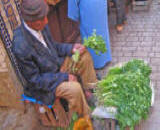 Women covered with colorful headscarves and kaftans, carrying
babies, rode by on donkeys. Fields of prickly pear cactus fences formed the dual purpose of
keeping the livestock contained as well as providing the fruit to be sold at the
market. Pastures of greens, likely mint and cilantro, for the markets that are
chock-a-block full to supply locals for mint tea. Women covered with colorful headscarves and kaftans, carrying
babies, rode by on donkeys. Fields of prickly pear cactus fences formed the dual purpose of
keeping the livestock contained as well as providing the fruit to be sold at the
market. Pastures of greens, likely mint and cilantro, for the markets that are
chock-a-block full to supply locals for mint tea.
Lining the tracks,
scavengers in their make shift slum houses, built of
plastic, cardboard, crumbling cement and corrugated metal. Astoundingly atop the
flat roofs held down by boulders was almost always a sat dish!
Approaching the numerous train stations along the
way, tents with squatters living among the garbage and litter, reminding
us of the extreme poverty that Morocco endures. Town consisted
packed crumbling stained apartment complexes 4-5 stories high.
After 4 hours, we reached the train
station where there were touts all over us trying to arrange a taxi
for us. But we politely said "No thanks" and headed across the
street where we hired a taxi for less than half what the touts were
demanding. |
|
Djemaa el-Fna
We were dropped off in the chaotic and
hectic main Square. Horse drawn carriages lined the cobblestone
entrance. We ventured into the bustling touristy area full of lively
energy and touts fighting over the attentions of the tourists.
Beautiful pebbled mosaics underfoot contribute to the
sensation that the plaza is a big outdoor room. |
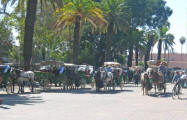 |
 |
|
|
 |
Snake
Charmers
During the day the big main square is alive with performers playing music and
dancing, men playing games, women spread out on a mat on the cobblestone,
selling whatever they can.
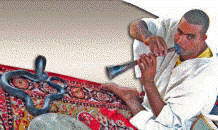
A truly great public place, we marvelled
at the Snake Charmers with their cobras, |
Unfortunately we found the snake charmers a
commercial touristy venue. You had to negotiate how much you were
willing to pay to take a photo before the "charmer" would put his
lips to the flute. Then it was obvious that the snake was totally
disinterested, probably as a result of "performing" day in day out
in the intense heat of the sun when it would have preferred to have
been sleeping under a rock somewhere. It was usually the result of
the noise from a shaking tambourine that would finally arouse the
snake. |
|
Travelling Dentists
with their table full of teeth (You choose which teeth you want),
|
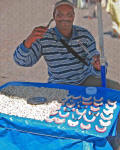 |
Women in pantaloons and shawls spread out on the
grey stone ground, selling bath mitts, baskets, baked goods,
whatever they could. Henna Painters would rush up and
grab your arm as you exclaimed no, NO... but the paint was
applied so quickly you couldn't retrieve your arm in time for
them to demand 50 Euros for their work! |
 |
Monkeys on leashes, strolling Berber
Musicians,
Dancers....a great sense of life!
Laid out on the rough ground were mats selling
trinkets, like the camels pictured left. |
| |
|
|
|
|
|
 |
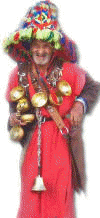 |
 |
|
 |
|
 |
| Selling dried fruit and nuts |
|
Freshly squeezed orange juice |
|
Moroccan carpets |
|
The Colorful Water Man |
|
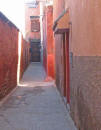 |
Riads
After our walk around the town's main square
it was time to hunt down our Riad. Riads are the common form of accommodation in Morocco, traditional homes
having been converted to guesthouses. ‘Riad’ means ‘garden’. The concept of a
Riad is that of a family house which is completely closed to the outside world
complete with its internal courtyard and garden in the center, a water fountain
and individual bedrooms with common living rooms shared by the whole extended
family.
We had a general idea of where the rooms were
but all the narrow streets looked identical and of course
there are no street signs. We just wandered around passing
many nondescript doorways that offered accommodation until
we found ours, Hotel Central Palace. |
 |
|
Our room was
basic but had the necessities and was only 25 Euros
including breakfast. Our ground floor room looked out into
the courtyard, decorated with potted plants and Moroccan
carpets. |
|
Night time Food
stalls
After
settling in to the riad, we ventured back out to the Square. At night
the venues change and the Square becomes alive with a whole new
ambience. Row upon row of eateries are magically set up offering Moroccan
food. Unless you are hungry it's best to stay away from the area because you
will have 20 guys converge on you trying to drag you off in different directions
to eat at their booth.
|
 |
|
Oct 9,2009
Even early in the day there was lots of activity
in the streets. The narrow roads were given up to bicycles, horses and donkeys pulling carts, many
piled unbelievably high with goods.
Being Muslim, the
majority of women wore head scarves and
tunics, some older women being fully covered in
burkes and veils.
But you could see that the younger generation of girls are
being influenced by the western tourists and have succumbed to leaving their
heads uncovered. Most men still wear the long caftans (jallabas) with pointy
hood and fez. |
 |
 |
|
'Mazing Medina
We walked through the main entrance to the Medina
(walled city) called BabBou Jelouid, built in 1913.
The Medina is the heart of the city, where the life is, a
meeting place for people, a great sense of culture. The vast
area of criss-crossed narrow alleys, sometimes connected
with tunnels were chock a block full of souks offered
everything imaginable (and lots that wasn't). |
 |
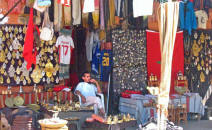 |
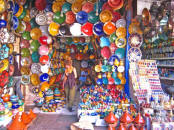 |
|
The bright colors of the shops with their
cramped sections of various inimitable items could have kept us busy all
day. Shops of copper and silver here, shops of trinkets and
shawls there, colourful ceramics and then shoes and
slippers, t-shirts, jewelry from
coral, shells, stones and amber. Many bazaars that one could rummage
through piles of dusty antiques to find hidden treasures
buried beneath mounds of kettles, knives, mirrors, pipes and
baskets, old muskets,
carved boars tusks, containers that once carried
gunpowder, bone and bronze water flasks, inlaid boxes, brassware. |
|
Around each corner, new sights and smells. The
pungent odour of turmeric, garlic, and cumin wafting from the open
bins of spices.
And soaps of various beckoning fragrances like
jasmine & lavender. |
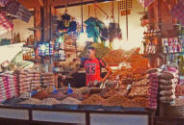 |
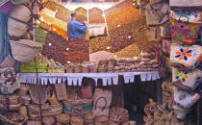 |
At one of the spice stall where I was purchasing
saffron (very expensive here), Gord was asked if he would like to
purchase some curry...a special deal by the square meter! The seller
invited Gord to his house in the hills to inspect the curry. It took
Gord a while to figure out that curry was code for kif! |
|
Scarved women in shawls carried trays of bread dough for baking in wood-fired ovens. Outdoor street stalls
sold almond-filled pastries or flatbreads; among them kids played
soccer in narrow cobblestone alleys. The air was vibrant with the
sounds of chatter. Although Morocco is
supposedly French, we
mostly heard Arabic spoken, along with the traditional Berber.
The Moroccan men all have the
habit of continuous scratching and
"adjusting" their crotch. And it seems they
are constantly picking their noses! We came
to accept this practice except when they
always wanted to shake your hand! And you
see women spitting in the street. We
certainly are not used to these customs but
it is their way of life and is perfectly
normal behaviour to them.
The touts were relentless and the pressure to buy was
ruthless. If you dared to look interested in an item, even with a
quick glance, the shopkeeper would be all over you. We had one young
boy chase us all over the Medina for several hours "Mister, just
give me a number." We politely told him NO THANKS NOT INTERESTED but
every time we would emerge from another shop, there he was waiting
to pounce!
And if you looked the least bit lost, faux guides
would offer to take you around "to practice their English only" but
before long you would be scuttled into "an uncle's" or "brother's"
or "father's" shop for "the best price."

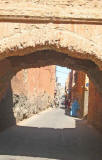 Our visit to Marrakesh did not do much to
improve our attitude towards the Arabs. We were constantly hassled
and, under the pretence of wanting to be your friend,
they have countless schemes to extract money from gullible visitors. It is easy
to get lost in the Kasbahs and souks of Marrakesh and that's when they strike.
They wouldn't help without their hand out for "baksheesh" (money). Our visit to Marrakesh did not do much to
improve our attitude towards the Arabs. We were constantly hassled
and, under the pretence of wanting to be your friend,
they have countless schemes to extract money from gullible visitors. It is easy
to get lost in the Kasbahs and souks of Marrakesh and that's when they strike.
They wouldn't help without their hand out for "baksheesh" (money).
We asked one young boy which way to
BabBou Jelouid and he motioned "Come I show" so we followed him about 20 meters
along the passageway until it rounded a bend and with one hand he
pointed a head and the other hand was outstretched "Please, for my
family." He couldn't have walked 15 paces and he wanted money!!!!
And it seemed that most of the touts, many teenage
boys, all seemed to have cut faces, marked by slashes or bruises.
This reason for this characteristic became apparent as we witness a
number of street fights during our 4 day stay in Marrakesh and again
in Fes. I think the Moroccan Muslim race is fairly violent in nature
and disposition.
|
|
Moroccan Carpets
The meticulously crafted Moroccan carpets draped the
walls of the streets like flags. The carpets are truly beautiful and
I ventured into a Carpet shop and was immediately told to "sit,
would you like tea." No Thanks I replied, just looking. Suddenly
"Which color you want?" "You buy this one, good price." The man
started to hurriedly unroll the carpets, stacks of them and they fell in layers at my feet
before I could protest. All colors, patterns, styles, prayer rugs, kilims, runners, all beautiful
and all very expensive. I explained that we lived on a boat with no floor area
for such beautiful carpets but he insisted he would deliver anywhere
in the world. It was hard to escape the clutches of that guy! |
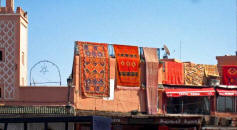 |
|
The Tannery
We followed donkeys laden with raw sheep, cow and camel hides to The tannery.
It was very stinky and so we were given mint to stuff up our
noses! Pigeon poo is used to soften the leather, and then cow's urine to color
it. Big vats of smelly brown stuff cover the yard amidst hides being set out to
dry, then beaten to softness. |
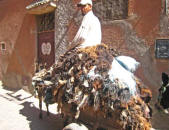 |
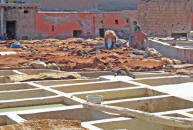 |
|
 |
|
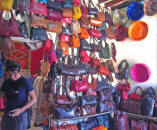 Morocco is known for its soft leather and sell shoes, purses, cushions, etc.
|
The Bahia Palace,
built
in the late 19th century, is a
superb example of Moroccan-Islamic
architecture. The layout of the
complex, with its courtyards and
mazes of rooms, is typical of the
style. The palace has been well
restored and maintained, and its
gorgeous tiles and carvings are
quite impressive.
The intricate decor,
beautiful tile work and inlaid
mosaics were breathtaking. The
doorways and window shutters were
works of art! Outside was a
courtyard garden with fountains and
tropical plants. |
 |
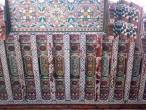 |
|
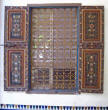 |
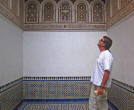 |
|
|
Spice Market
We were enticed into the
Spice Market, supposedly only open the
one day of the week (another ploy for
extraction of money). We did take the
opportunity to sit and drink tea with a
young man in a little shop of potents
and spices with "magical powers."
|
 |
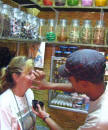 |

|
|
Gord inhales the scent of a spice
that will clear his sinus' and give him
a feeling of well being! |
I got some sticky white
goop dabbed onto my face with the
promise it would make me look younger |
Did it work? |
|